Dynamic Change and Attribution Regarding Fractional Vegetation Coverage in Mengdong River Basin
Abstract
:1. Introduction
2. Study Area and Data
2.1. Study Area
2.2. Data and Preprocessing
3. Research Methods
3.1. Calculation of Vegetation Coverage
3.2. Trend Check
- (1)
- Mann–Kendall (MK) test
- (2)
- Sen slope estimation
3.3. Hurst Index
3.4. Partial Correlation Analysis
3.5. Multivariate Residual Analysis
4. Result Analysis and Discussion
4.1. Characteristics and Spatial Distribution of Interannual Mean Value of FVC
4.2. Changing Trend and Future Trend of FVC
4.3. Relationship between FVC Change and Climate
4.4. Driving Force of FVC Change and Contribution Rate of Each Factor
5. Conclusions
Author Contributions
Funding
Data Availability Statement
Conflicts of Interest
References
- Wang, S. Concept Deduction and Its Connotation. Carsologica Sin. 2002, 21, 101–105. [Google Scholar]
- Cui, J.; Wen, Q.; Huang, J. Study on comprehensive treatment of rocky desertification in karst area. Soil Water Conserv. China 2024, 4, 49–52. [Google Scholar]
- Wu, D.; Cai, Y. Evaluation of Ecological Restoration Effects in China: A Review. Prog. Geogr. 2009, 28, 622–628. [Google Scholar]
- Long, M.; Bai, X.; Li, Z.; Xue, Y.; Chen, F.; Li, C.; Ran, C.; Zhang, S.; Du, C.; Song, F.; et al. Positive contribution and negative impact of karst rocky desertification control on biodiversity in southwest China. Acta Geogr. Sin. 2024, 79, 97–113. [Google Scholar]
- Guo, B.; Yang, F.; Fan, Y.; Zang, W. The dominant driving factors of rocky desertification and their variations in typical mountainous karst areas of southwest China in the context of global change. Catena 2023, 220, 106674. [Google Scholar] [CrossRef]
- Xu, E.; Zhang, H.; Li, M. Mining spatial information to investigate the evolution of karst rocky desertification and its human driving forces in Changshun, China. Sci. Total Environ. 2013, 458, 419–426. [Google Scholar] [CrossRef] [PubMed]
- Xu, H.; Wang, Y.; Su, Q.; Li, Z.; Jia, Y. Evolution of rock desertification and driving factors in typical karst areas of Yunnan province. J. Arid Land Resour. Environ. 2022, 36, 94–101. [Google Scholar]
- Wen, Y.; Cai, H.; Han, D. Driving factors analysis of spatial-temporal evolution of vegetation ecosystem in rocky desertification restoration area of Guizhou Province, China. Environ. Sci. Pollut. Res. Int. 2024, 31, 13122–13140. [Google Scholar] [CrossRef] [PubMed]
- Li, Y.; Sun, B.; Gao, Z.; Su, W.; Wang, B.; Yan, Z.; Gao, T. Extraction of rocky desertification information in karst area by using different multispectral sensor data and multiple endmember spectral mixture analysis method. Front. Environ. Sci. 2022, 10, 996708. [Google Scholar] [CrossRef]
- Chen, X.; Vierling, L.; Rowell, E.; DeFelice, T. Using lidar and effective LAI data to evaluate IKONOS and Landsat 7 ETM+ vegetation cover estimates in a ponderosa pine forest. Remote Sens. Environ. 2004, 91, 14–26. [Google Scholar] [CrossRef]
- Gitelson, A.; Kaufman, Y.; Stark, R.; Rundquist, D. Novel algorithms for remote estimation of vegetation fraction. Remote Sens. Environ. 2002, 80, 76–87. [Google Scholar] [CrossRef]
- Cai, H.; Yang, X.; Wang, K.; Xiao, L. Is Forest Restoration in the Southwest China Karst Promoted Mainly by Climate Change or Human-Induced Factors? Remote Sens. 2014, 6, 9895–9910. [Google Scholar] [CrossRef]
- Tong, X.; Wang, K.; Yue, Y.; Brandt, M.; Liu, B. Quantifying the effectiveness of ecological restoration projects on long-term vegetation dynamics in the karst regions of Southwest China. Int. J. Appl. Earth Obs. Geoinf. 2017, 54, 105–113. [Google Scholar] [CrossRef]
- Tong, X.; Brandt, M.; Yue, Y.; Horion, S.; Wang, K. Increased vegetation growth and carbon stock in China karst via ecological engineering. Nat. Sustain. 2018, 1, 44. [Google Scholar] [CrossRef]
- Brandt, M.; Yue, Y.; Wigneron, J.; Tong, X.; Tian, F. Satellite-observed major greening and biomass increase in South China karst during recent decade. Earth’s Future 2018, 6, 1017–1028. [Google Scholar] [CrossRef]
- Liao, C.; Yue, Y.; Wang, K.; Fensholt, R.; Tong, X. Ecological restoration enhances ecosystem health in the karst regions of southwest China. Ecol. Indic. 2018, 90, 416–425. [Google Scholar] [CrossRef]
- Zhang, W.; Cao, J.; Wu, X. Dynamic monitoring and control benefits of vegetation in rocky desertification areas based on Landsat images. Trans. Chin. Soc. Agric. Eng. (Trans. CSAE) 2019, 35, 221–229. [Google Scholar]
- Zhou, H.; Wang, Z.; Wu, X.; Chen, Y.; Zhong, Y.; Li, Z.; Chen, J.; Li, J.; Guo, S.; Chen, X. Spatiotemporal Variation of Annual Runoff and Sediment Load in the Pearl River during 1953–2017. Sustainability 2019, 11, 5007. [Google Scholar] [CrossRef]
- Stow, D.; Hope, A.; McGuire, D.; Verbyla, D.; Gamon, J. Remote sensing of vegetation and land-cover change in Arctic tundra ecosystems. Remote Sens. Environ. 2004, 89, 281–308. [Google Scholar] [CrossRef]
- Lamchin, M.; Lee, M.; Jeon, W.; Wang, W.; Lim, H. Long-term trend of and correlation between vegetation greenness and climate variables in Asia based on satellite data. Methodsx 2018, 618, 803–807. [Google Scholar] [CrossRef]
- Xue, X.; Wang, Z.; Hou, S. NDVI-Based Vegetation Dynamics and Response to Climate Changes and Human Activities in Guizhou Province, China. Forests 2023, 14, 753. [Google Scholar] [CrossRef]
- Liu, Y.; Li, L.; Chen, X.; Zhang, R.; Yang, J. Temporal-spatial variations and influencing factors of vegetation cover in Xin jiang from 1982 to 2013 based on GIMMS-NDVI3g. Glob. Planet. Chang. 2018, 169, 145–155. [Google Scholar] [CrossRef]
- Li, Y.; Cao, Z.; Long, H.; Liu, Y.; Li, W. Dynamic analysis of ecological environment combined with land cover and NDVI changes and implications for sustainable urban-rural development: The case of Mu Us Sandy Land, China. J. Clean. Prod. 2016, 142, 697–715. [Google Scholar] [CrossRef]
- Wande, G.; Ce, Z.; Liu, X.; Lu, Y.; Chen, Y.; Wei, Y.; Ma, Y. NDVI-based vegetation dynamics and their responses to climate change and human activities from 1982 to 2020: A case study in the Mu Us Sandy Land, China. Ecol. Indic. 2022, 137, 108745. [Google Scholar]
- Xu, X.; Liu, H.; Jiao, F.; Gong, H.; Lin, Z. Time-varying trends of vegetation change and their driving forces during 1981-2016 along the Silk Road Economic Belt. Catena 2020, 195, 104796. [Google Scholar] [CrossRef]
- Yan, D.; Wu, X.; Wang, B.; Hao, H. Characteristics and driving forces of changes in vegetation coverage on the Loess Plateau, 1982–2015. Acta Ecol. Sin. 2023, 43, 9794–9804. [Google Scholar]
- Zhang, X.; Wang, K.; Yue, Y.; Tong, X.; Liao, C. Factors impacting on vegetation dynamics and spatial non-stationary relationships in karst regions of southwest China. Acta Ecol. Sin. 2017, 37, 4008–4018. [Google Scholar]
- Chen, T.; Huang, Q.; Wang, Q. Differentiation characteristics and driving factors of ecosystem services relationships in karst mountainous area based on geographic detector modeling: A case study of Guizhou Province. Acta Ecol. Sin. 2022, 42, 6959–6972. [Google Scholar]
- Ma, B.; He, C.; Jing, J.; Wang, Y.; Liu, B. Attribution of vegetation dynamics in Southwest China from 1982 to 2019. Acta Geogr. Sin. 2023, 78, 714–728. [Google Scholar]
- Jin, K.; Wang, F.; Han, J.; Shi, S.; Ding, W. Contribution of climatic change and human activities to vegetation NDVI change over China during 1982–2015. Acta Geogr. Sin. 2020, 75, 961–974. [Google Scholar]
- Qi, X.; Jia, J.; Liu, H.; Lin, Z. Relative importance of climate change and human activities for vegetation changes on China’s silk road economic belt over multiple timescales. Catena 2019, 180, 224–237. [Google Scholar] [CrossRef]
- Shi, S.; Yu, J.; Wang, F.; Wang, P.; Zhang, Y.; Jin, K. Quantitative contributions of climate change and human activities to vegetation changes over multiple time scales on the Loess Plateau. Sci. Total Environ. 2021, 755, 142419. [Google Scholar] [CrossRef] [PubMed]
- Deng, Y.; Wang, Z.; Lu, S.; Zhong, J.; Zhu, L.; Chen, F.; Wu, L. Soil quality assessment via the factor analysis of karst rocky desertification areas in Hunan, China. Soil Use Manag. 2021, 38, 248–261. [Google Scholar] [CrossRef]
- Gen, G. The trend of rocky desertification land expansion in China is reversed—The National Forestry and Grassland Administration announces the third monitoring result of rocky desertification. Green China 2018, 23, 8–11. [Google Scholar]
- Guanyao, L. Concentrated Stream Data Processing for Vegetation Coverage Monitoring and Recommendation against Rock Desertification. Processes 2022, 10, 2628. [Google Scholar] [CrossRef]
- Li, S.; Zhou, Z.; Ma, R.; Liu, S.; Guan, Q. Extracting subpixel vegetation NDVI time series for evaluating the mixed pixel effect on GPP estimation in urban areas. Int. J. Digit. Earth 2023, 16, 3222–3238. [Google Scholar] [CrossRef]
- Xie, Y.; Li, Z.; Zhu, L.; Zhou, Y.; Liu, H.; Yu, T. Dynamic monitoring of desertification in response to climatic factors: A case study from the Gelintan Oasis on the southeastern edge of the Tengger Desert, China. Geocarto Int. 2022, 37, 9453–9473. [Google Scholar] [CrossRef]
- Wang, X.; Song, J.; Xiao, Z.; Wang, J.; Hu, F. Desertification in the Mu Us Sandy Land in China: Response to climate change and human activity from 2000 to 2020. Geogr. Sustain. 2022, 3, 177–189. [Google Scholar] [CrossRef]
- Hadi, D.; Hamid, G.; Telfer, W.; Rodrigo, J.; Collins, L.; Jansen, D. Desertification of Iran in the early twenty-first century: Assessment using climate and vegetation indices. Sci. Rep. 2021, 11, 20548. [Google Scholar]
- Tong, X.; Wang, K.; Brandt, M.; Yue, Y.; Liao, C.; Fensholt, R. Assessing Future Vegetation Trends and Restoration Prospects in the Karst Regions of Southwest China. Remote Sens. 2016, 8, 357. [Google Scholar] [CrossRef]
- Yan, Y.; Xin, Z.; Bai, X.; Zhan, H.; Xi, J.; Xie, J.; Cheng, Y. Analysis of Growing Season Normalized Difference Vegetation Index Variation and Its Influencing Factors on the Mongolian Plateau Based on Google Earth Engine. Plants 2023, 12, 2550. [Google Scholar] [CrossRef] [PubMed]
- Qi, X.; Sheng, H. Hurst Index Analysis of Social Electricity Consumption Change Trend Based on R/S Analysis. IOP Conf. Ser. Mater. Sci. Eng. 2020, 750, 012150. [Google Scholar] [CrossRef]
- Pei, J.; Wang, L.; Wang, X.; Niu, Z.; Kelly, M.; Song, X.P.; Huang, N.; Geng, J.; Tian, H.; Yu, Y.; et al. Time Series of Landsat Imagery Shows Vegetation Recovery in Two Fragile Karst Watersheds in Southwest China from 1988 to 2016. Remote Sens. 2019, 11, 2044. [Google Scholar] [CrossRef]
- Kim, J.; Hong, S.; Choi, I. Partial Correlation Analysis and Neural-Network-Based Prediction Model for Biochemical Recurrence of Prostate Cancer after Radical Prostatectomy. Appl. Sci. 2023, 13, 891. [Google Scholar] [CrossRef]

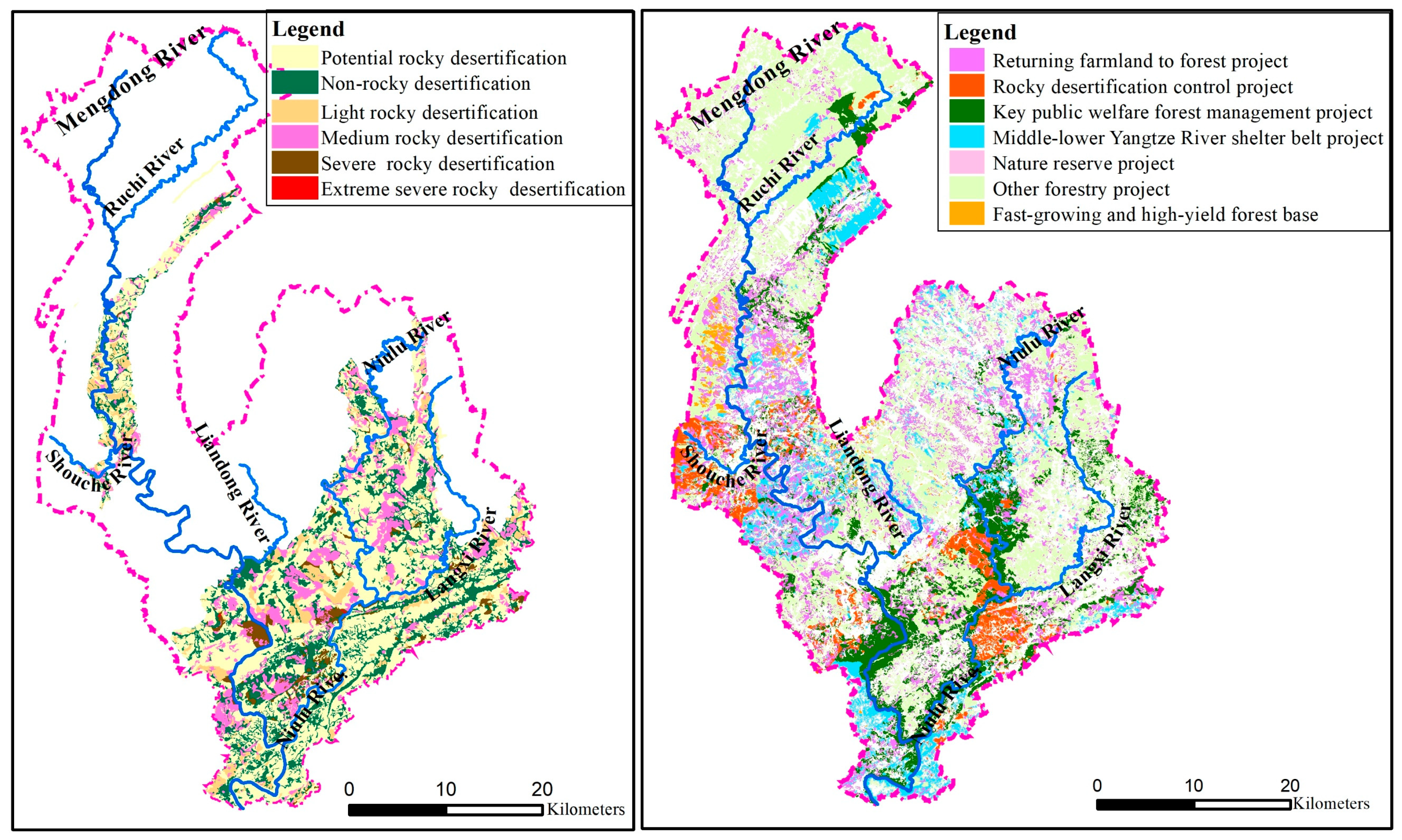
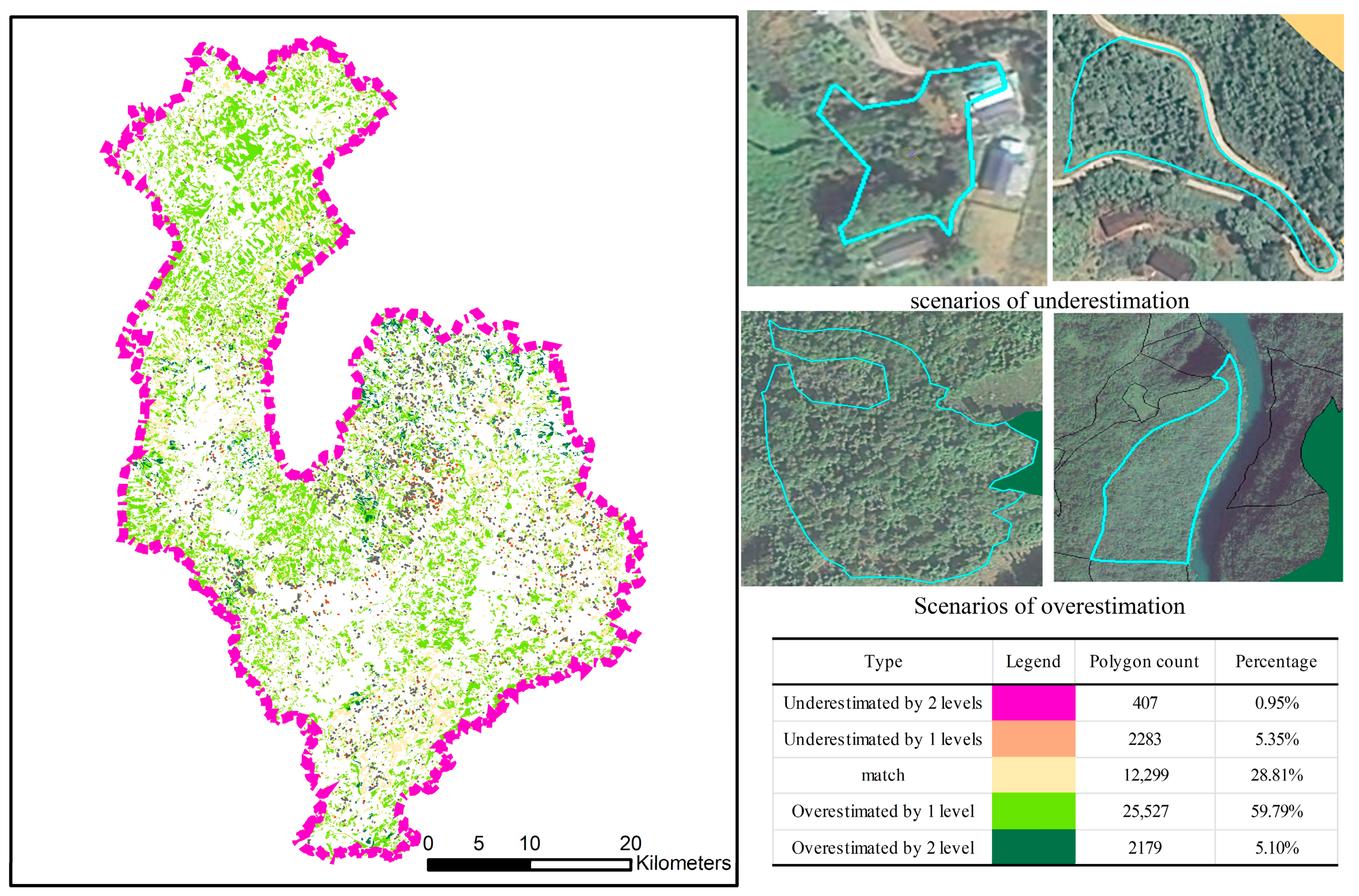

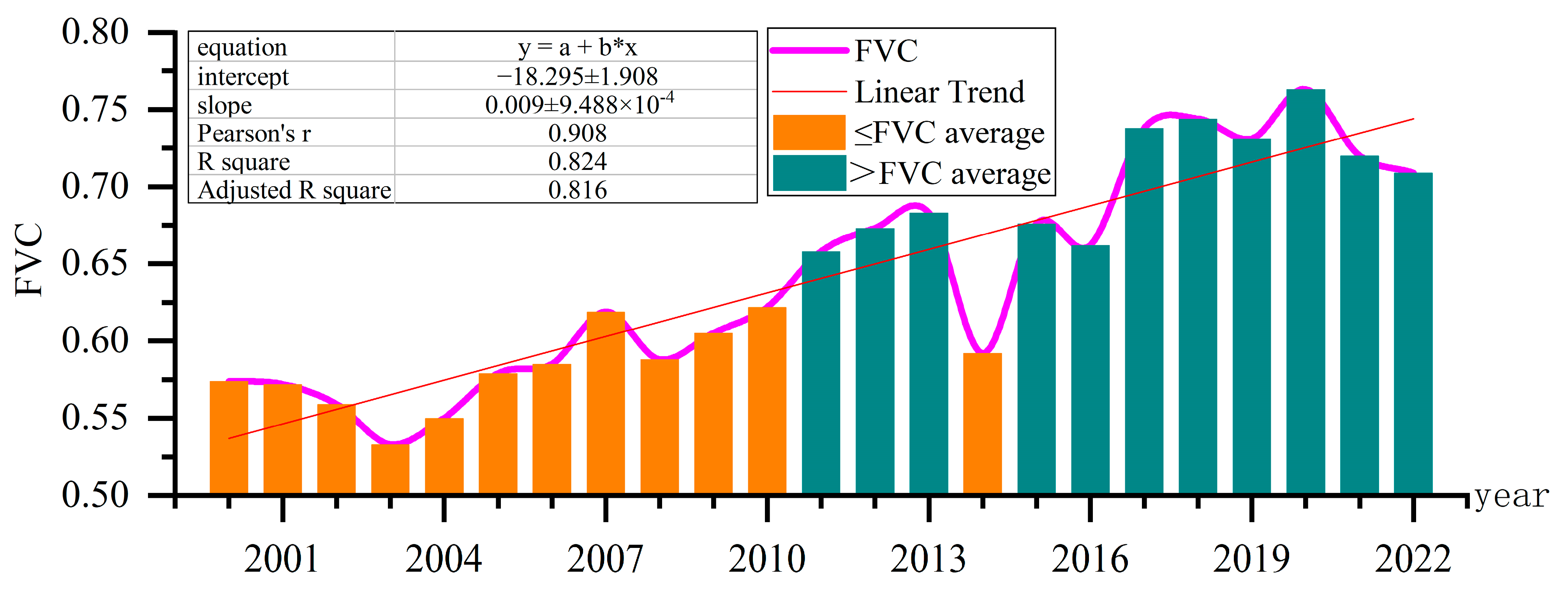



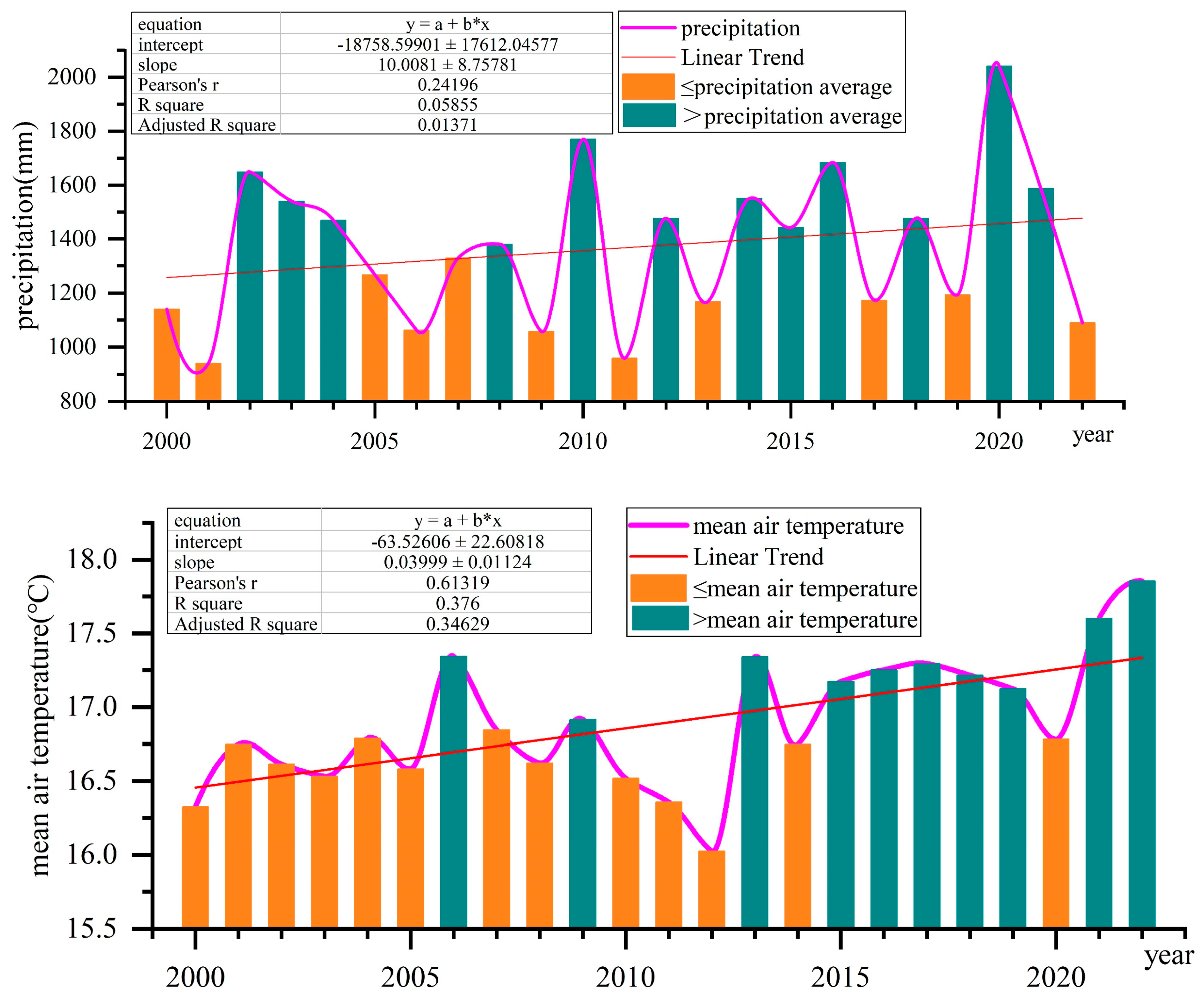
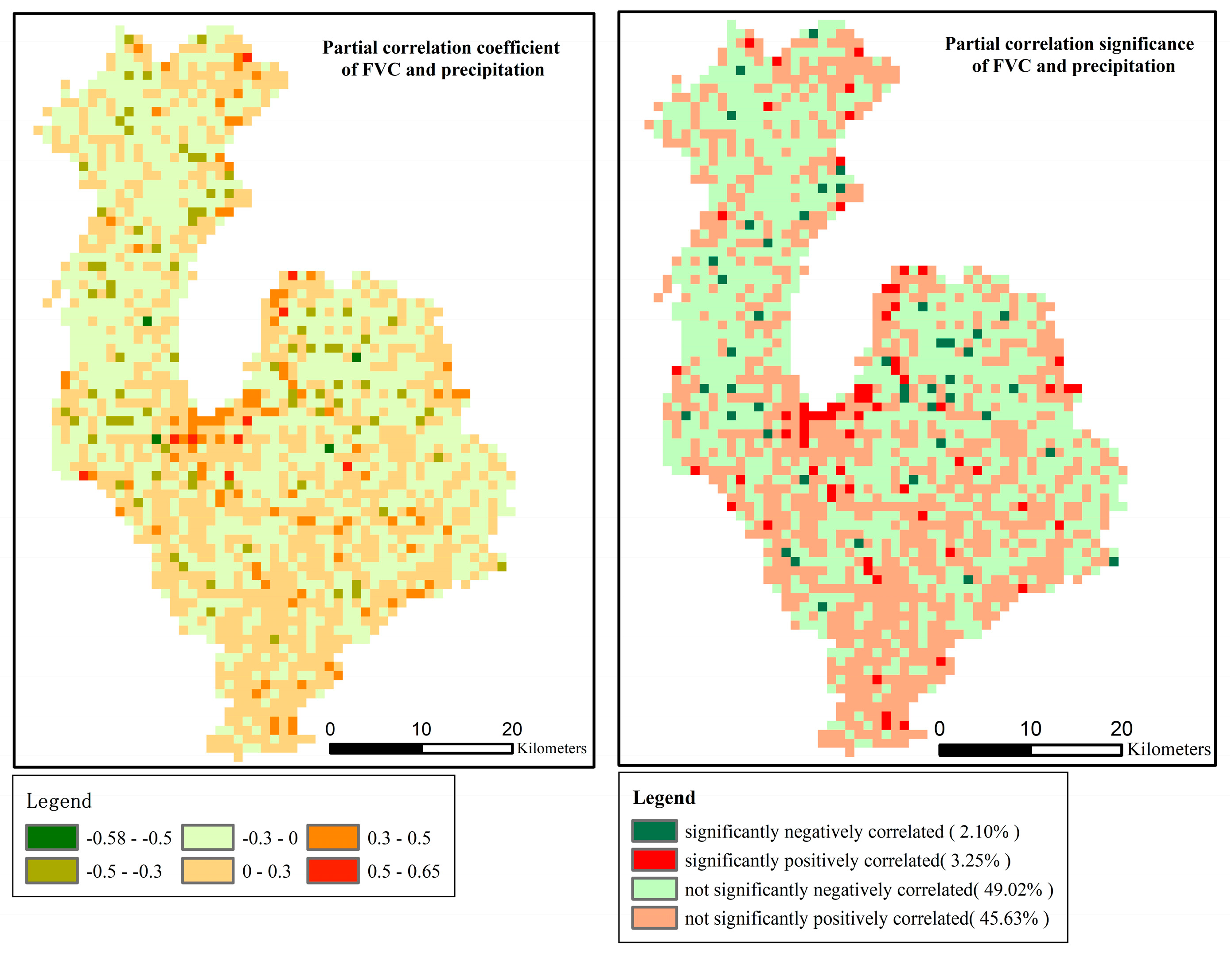
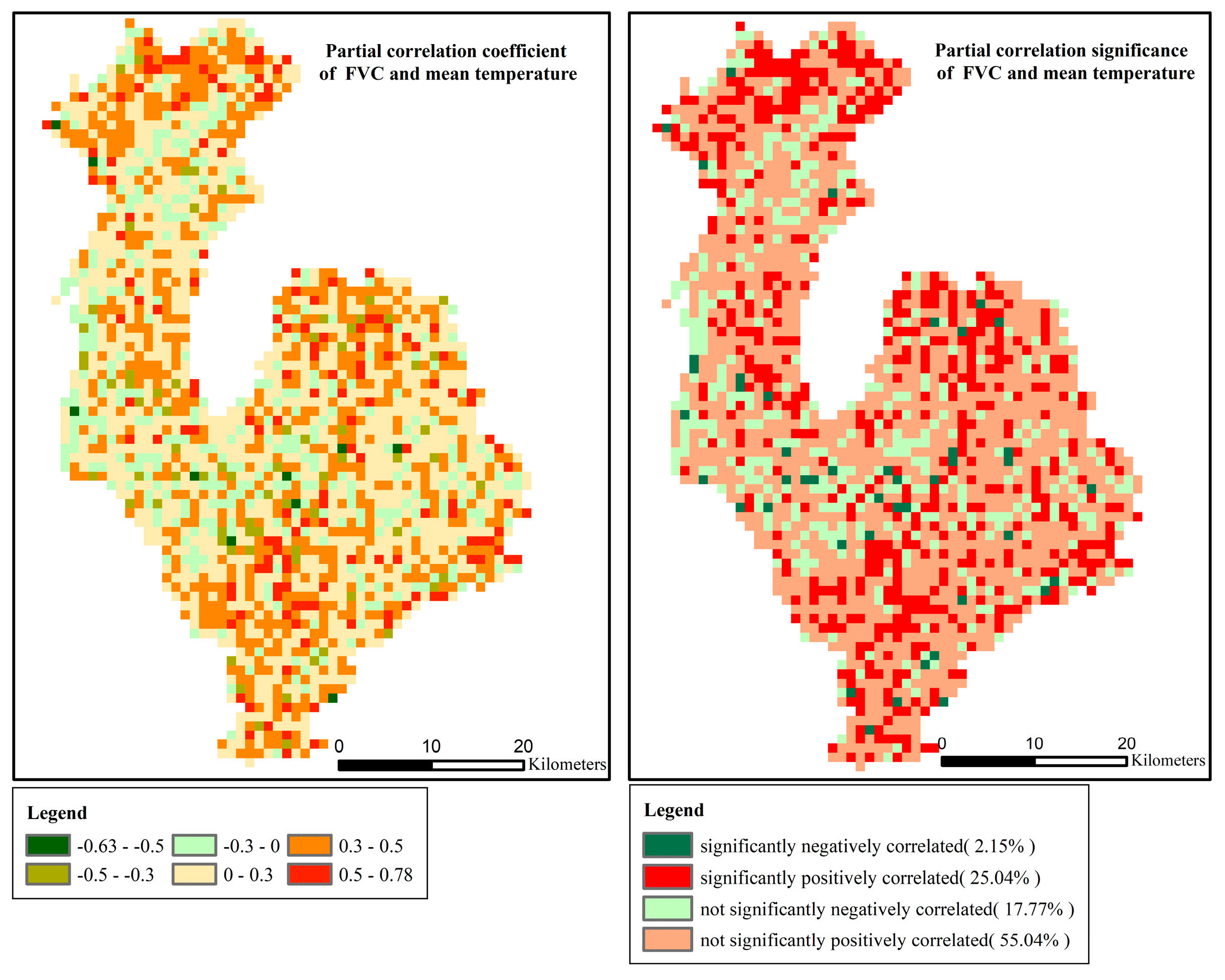

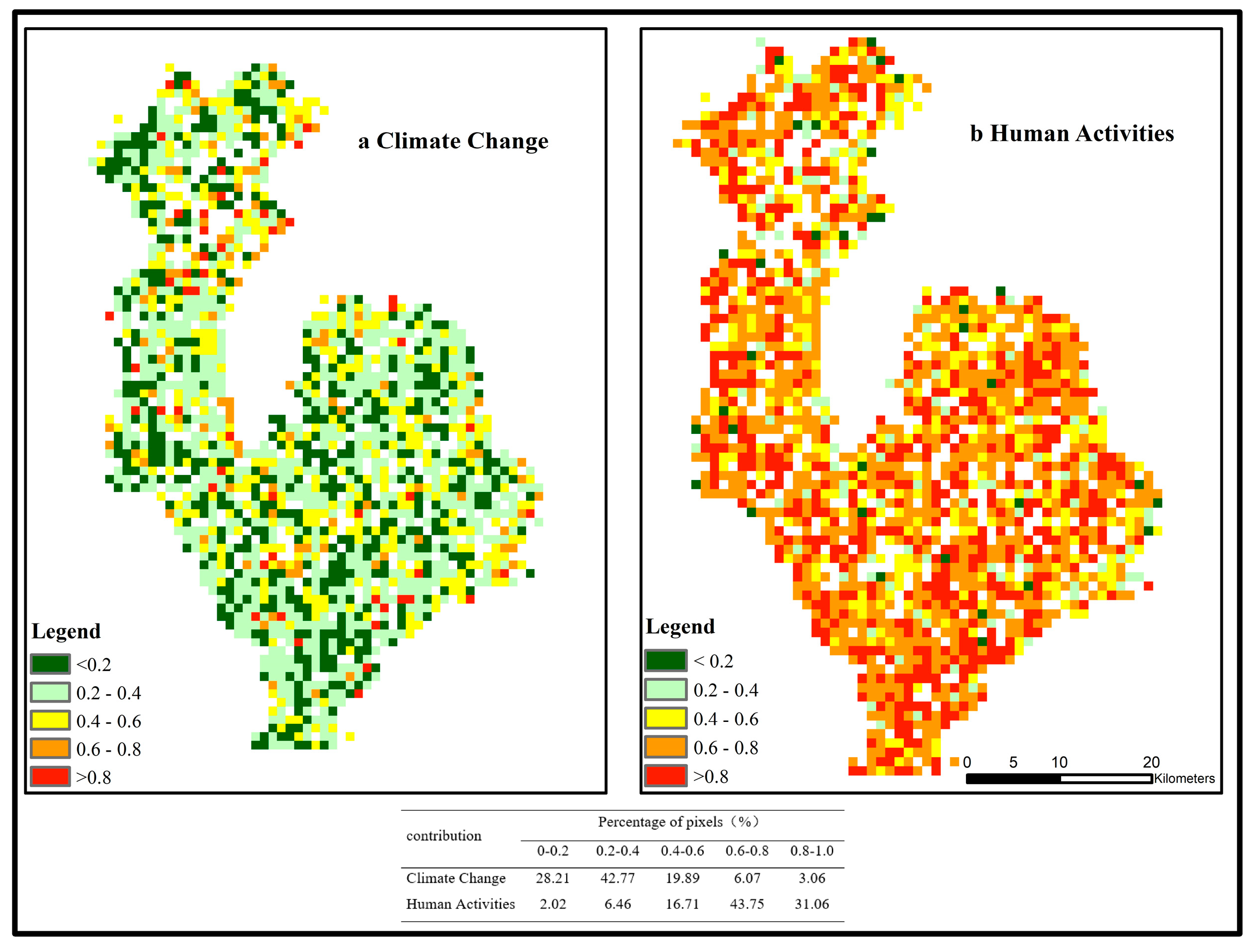
| β | Zmk | Trend Category | Trend Feature |
|---|---|---|---|
| β > 0 | Z > 2.58 | 3 | Dramatic growth |
| 1.96 < Z ≤ 2.58 | 2 | Significant growth | |
| Z ≤ 1.96 | 1 | Insignificant growth | |
| β = 0 | 0 | No change | |
| β < 0 | Z ≤ 1.96 | −1 | Insignificant reduction |
| 1.96 < Z ≤ 2.58 | −2 | Significant reduction | |
| 2.58 < Z | −3 | Very significant reduction |
| TS | |Z| | Hurst Index | Classification | Code |
|---|---|---|---|---|
| >0 | >2.58 | >0.75 | Highly stable and extremely significant growth | 6 |
| >0.5 ≤ 0.75 | Weakly stable and extremely significant growth | 5 | ||
| >1.96 ≤2.58 | >0.75 | Highly stable and significant growth | 4 | |
| >0.5 ≤ 0.75 | Weakly stable and significant growth | 3 | ||
| ≤1.96 | >0.75 | Highly stable and insignificant growth | 2 | |
| >0.5 ≤ 0.75 | Weakly stable and insignificant growth | 1 | ||
| <0 | ≤1.96 | >0.5 ≤ 0.75 | Weakly stable and insignificant reduction | −1 |
| >0.75 | Highly stable and insignificant reduction | −2 | ||
| >1.96 ≤2.58 | >0.5 ≤ 0.75 | Weakly stable and significant reduction | −3 | |
| >0.75 | Highly stable and significant reduction | −4 | ||
| >2.58 | >0.5 ≤ 0.75 | Weakly stable and extremely significant reduction | −5 | |
| >0.75 | Highly stable and extremely significant reduction | −6 | ||
| ≤0.5 | Instability | 0 | ||
| R | |p| Confidence Level | Classification |
|---|---|---|
| >0 | ≤0.01 | Extremely significant positive correlation |
| >0 | ≤0.05 | Significant positive correlation |
| >0 | >0.05 | Non-significant positive correlation |
| <0 | >0.05 | Non-significant negative correlation |
| <0 | ≤0.05 | Significant negative correlation |
| <0 | ≤0.01 | Extremely significant negative correlation |
| Driver Classification Criteria | Driving Factor | Contribution Rates of Drivers (%) | |||
|---|---|---|---|---|---|
| Climate Change | Human Activities | ||||
| >0 | >0 | >0 | CC & HA | ||
| >0 | <0 | CC | 100 | 0 | |
| <0 | >0 | HA | 0 | 100 | |
| <0 | <0 | <0 | CC & HA | ||
| <0 | >0 | CC | 100 | 0 | |
| >0 | <0 | HA | 0 | 100 | |
| FVC Mean Value | 2000–2002 | 2003–2005 | 2006–2008 | 2009–2011 | 2012–2014 | 2015–2017 | 2018–2020 | 2021–2022 | |
|---|---|---|---|---|---|---|---|---|---|
| Rocky Desertification Monitoring Area | |||||||||
| Rocky desertification monitoring area | 0.556 | 0.535 | 0.554 | 0.607 | 0.647 | 0.686 | 0.727 | 0.708 | |
| Non-rocky desertification monitoring area | 0.576 | 0.567 | 0.625 | 0.644 | 0.651 | 0.696 | 0.758 | 0.719 | |
| FVC Mean Value | 2000–2002 | 2003–2005 | 2006–2008 | 2009–2011 | 2012–2014 | 2015–2017 | 2018–2020 | 2021–2022 | |
|---|---|---|---|---|---|---|---|---|---|
| Land Cover | |||||||||
| Forestland | 0.639 | 0.630 | 0.676 | 0.710 | 0.740 | 0.780 | 0.828 | 0.800 | |
| Shrubland | 0.556 | 0.542 | 0.591 | 0.643 | 0.657 | 0.708 | 0.778 | 0.756 | |
| Other woodland | 0.522 | 0.515 | 0.571 | 0.607 | 0.616 | 0.677 | 0.761 | 0.730 | |
| Grassland | 0.468 | 0.441 | 0.467 | 0.510 | 0.528 | 0.572 | 0.628 | 0.608 | |
| Garden plot | 0.444 | 0.424 | 0.485 | 0.516 | 0.529 | 0.599 | 0.686 | 0.643 | |
| Plowland | 0.383 | 0.342 | 0.382 | 0.396 | 0.400 | 0.455 | 0.530 | 0.474 | |
| FVC Mean Value | 2000–2002 | 2003–2005 | 2006–2008 | 2009–2011 | 2012–2014 | 2015–2017 | 2018–2020 | 2021–2022 |
|---|---|---|---|---|---|---|---|---|
| Returning farmland to forest project | 0.542 | 0.539 | 0.615 | 0.686 | 0.716 | 0.767 | 0.823 | 0.797 |
| Rocky desertification control project | 0.685 | 0.677 | 0.697 | 0.742 | 0.758 | 0.795 | 0.841 | 0.816 |
| Key public welfare forest management project | 0.654 | 0.630 | 0.661 | 0.708 | 0.755 | 0.793 | 0.835 | 0.811 |
| Middle–lower Yangtze River shelter belt project | 0.663 | 0.653 | 0.693 | 0.733 | 0.750 | 0.789 | 0.830 | 0.800 |
| Nature reserve project | 0.751 | 0.761 | 0.790 | 0.777 | 0.803 | 0.812 | 0.861 | 0.834 |
| Other forestry projects | 0.652 | 0.647 | 0.691 | 0.712 | 0.738 | 0.777 | 0.831 | 0.800 |
| Fast-growing and high-yield forest base | 0.655 | 0.672 | 0.713 | 0.751 | 0.756 | 0.787 | 0.823 | 0.806 |
| FVC | FVC Grade | Classification |
|---|---|---|
| ≤10% | 1 | No cover and very low vegetation cover |
| 10% < FVC ≤ 30% | 2 | Low vegetation cover |
| 30% < FVC ≤ 50% | 3 | Medium vegetation cover |
| 50% < FVC ≤ 70% | 4 | More dense vegetation cover |
| >70% | 5 | Dense vegetation cover |
| FVC Grade | 1987 | 1990 | 1995 | 1999 | 2001 | 2004 | 2007 | 2010 | 2013 | 2016 | 2019 | 2022 |
|---|---|---|---|---|---|---|---|---|---|---|---|---|
| 1 | 4.83 | 1.48 | 1.77 | 2.09 | 0.86 | 2.33 | 2.18 | 4.51 | 3.11 | 3.66 | 3.12 | 2.96 |
| 2 | 12.15 | 9.04 | 8.81 | 15.04 | 6.67 | 11.01 | 7.67 | 7.91 | 5.30 | 6.13 | 4.00 | 3.98 |
| 3 | 23.76 | 24.83 | 29.80 | 29.81 | 26.46 | 26.88 | 16.91 | 14.65 | 10.61 | 11.92 | 7.39 | 7.94 |
| 4 | 28.06 | 34.16 | 37.00 | 28.90 | 39.95 | 32.78 | 32.16 | 27.81 | 21.53 | 24.36 | 15.86 | 19.66 |
| 5 | 31.20 | 30.49 | 22.62 | 24.16 | 26.06 | 27.00 | 41.08 | 45.12 | 59.45 | 53.93 | 69.63 | 65.46 |
| Project Category | Time Period | FVC1 | FVC2 | FVC3 | FVC4 | FVC5 |
|---|---|---|---|---|---|---|
| Returning farmland to forest project | 1 | 0.17% | 7.19% | 32.30% | 42.49% | 17.85% |
| 8 | 0.17% | 0.72% | 2.25% | 11.90% | 84.96% | |
| Rocky desertification control project | 1 | 0.04% | 1.03% | 8.46% | 39.11% | 51.36% |
| 8 | 0.12% | 0.41% | 1.15% | 9.44% | 88.88% | |
| Key public welfare forest management project | 1 | 0.09% | 1.69% | 12.64% | 44.50% | 41.08% |
| 8 | 0.22% | 0.59% | 1.75% | 9.60% | 87.84% | |
| Middle–lower Yangtze River shelter belt project | 1 | 0.09% | 1.72% | 14.21% | 39.56% | 44.42% |
| 8 | 0.12% | 0.51% | 1.74% | 11.79% | 85.84% | |
| Nature reserve project | 1 | 0.04% | 1.17% | 6.91% | 22.30% | 69.58% |
| 8 | 0.08% | 0.36% | 1.19% | 6.65% | 91.72% | |
| Other forestry projects | 1 | 0.06% | 2.34% | 15.36% | 39.75% | 42.49% |
| 8 | 0.20% | 0.63% | 2.17% | 11.98% | 85.02% | |
| Fast-growing and high-yield forest base | 1 | 0.06% | 0.80% | 10.29% | 49.80% | 39.05% |
| 8 | 0.10% | 0.42% | 1.31% | 10.58% | 87.59% |
| Change Trend | Area Proportion (%) | Hurst Index | Percentage of Area of This Trend Type (%) |
|---|---|---|---|
| Extremely significant growth | 52.64% | >0.75 | 81.16% |
| >0.5 ≤ 0.75 | 18.31% | ||
| Significant growth | 11.22% | >0.75 | 79.1% |
| >0.5 ≤ 0.75 | 20.21% | ||
| Insignificant growth | 23.82% | >0.75 | 77.41% |
| >0.5 ≤ 0.75 | 21.74% | ||
| No change | 0.08% | - | - |
| Insignificant reduction | 8.40% | >0.5 ≤ 0.75 | 20.28% |
| >0.75 | 79.03% | ||
| Significant reduction | 1.30% | >0.5 ≤ 0.75 | 13.92% |
| >0.75 | 85.69% | ||
| Extremely significant reduction | 2.54% | >0.5 ≤ 0.75 | 11.05% |
| >0.75 | 88.73% |
| Land Cover | Extremely Significant Growth | Significant Growth | Insignificant Growth | No Change | Insignificant Reduction | Significant Reduction | Extremely Significant Reduction |
|---|---|---|---|---|---|---|---|
| Rocky desertification monitoring area | 59.58% | 10.70% | 18.31% | 0.08% | 7.11% | 1.39% | 2.82% |
| Non-rocky desertification monitoring area | 48.37% | 11.61% | 27.10% | 0.09% | 9.20% | 1.25% | 2.38% |
| Engineering Category | Extremely Significant Growth | Significant Growth | Insignificant Growth | No Change | Insignificant Reduction | Significant Reduction | Extremely Significant Reduction |
|---|---|---|---|---|---|---|---|
| Returning farmland to forest project | 76.67% | 8.42% | 11.92% | 0.00% | 2.35% | 0.32% | 0.32% |
| Rocky desertification control project | 48.10% | 14.02% | 30.04% | 0.00% | 6.97% | 0.44% | 0.43% |
| Key public welfare forest management projects | 61.60% | 12.59% | 20.45% | 0.00% | 4.55% | 0.40% | 0.41% |
| Middle–lower Yangtze River shelter belt project | 49.89% | 11.55% | 28.80% | 0.00% | 8.76% | 0.52% | 0.48% |
| Nature reserve project | 24.42% | 11.06% | 41.31% | 0.00% | 21.16% | 1.04% | 1.01% |
| Other forestry projects | 50.82% | 12.91% | 27.33% | 0.00% | 7.73% | 0.62% | 0.59% |
| Fast-growing and high-yield forest base | 49.66% | 14.25% | 27.48% | 0.00% | 7.34% | 0.76% | 0.51% |
Disclaimer/Publisher’s Note: The statements, opinions and data contained in all publications are solely those of the individual author(s) and contributor(s) and not of MDPI and/or the editor(s). MDPI and/or the editor(s) disclaim responsibility for any injury to people or property resulting from any ideas, methods, instructions or products referred to in the content. |
© 2024 by the authors. Licensee MDPI, Basel, Switzerland. This article is an open access article distributed under the terms and conditions of the Creative Commons Attribution (CC BY) license (https://creativecommons.org/licenses/by/4.0/).
Share and Cite
Cao, D.; Wen, S. Dynamic Change and Attribution Regarding Fractional Vegetation Coverage in Mengdong River Basin. Forests 2024, 15, 746. https://doi.org/10.3390/f15050746
Cao D, Wen S. Dynamic Change and Attribution Regarding Fractional Vegetation Coverage in Mengdong River Basin. Forests. 2024; 15(5):746. https://doi.org/10.3390/f15050746
Chicago/Turabian StyleCao, Dan, and Shizhi Wen. 2024. "Dynamic Change and Attribution Regarding Fractional Vegetation Coverage in Mengdong River Basin" Forests 15, no. 5: 746. https://doi.org/10.3390/f15050746
APA StyleCao, D., & Wen, S. (2024). Dynamic Change and Attribution Regarding Fractional Vegetation Coverage in Mengdong River Basin. Forests, 15(5), 746. https://doi.org/10.3390/f15050746





